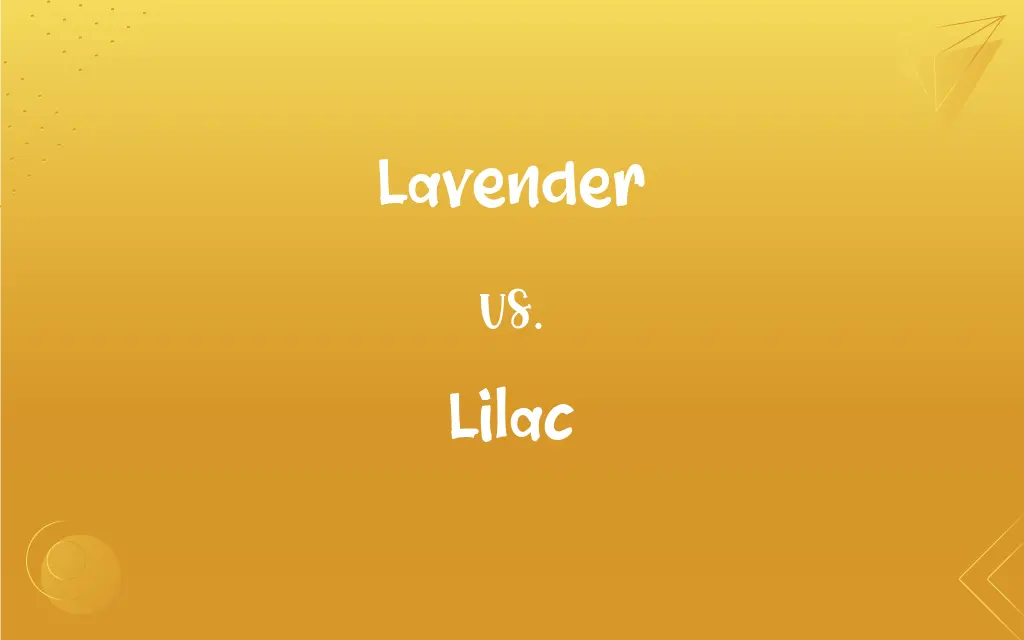Lavender vs. Lilac: What's the Difference?
Edited by Janet White || By Harlon Moss || Updated on October 5, 2023
Lavender and lilac refer to both colors and flowering plants; lavender typically indicates a pale purple with a bluish tint, while lilac is a light purple with a pinkish hue.

Key Differences
Lavender, both a plant and a color, invokes images of serene fields and a pale tint of purple. Lilac, likewise, can be recognized as a blooming plant or a light purple color, often with a slightly pinkish tone. Despite their similarities in the color spectrum, the hues recognized as lavender and lilac distinctively possess their respective bluish and pinkish tints, differentiating them in floral and design contexts.
Lavender, as a plant, belongs to the genus Lavandula, noted for its aromatic qualities and utilization in scents and culinary arts. Lilac, scientifically referred to as Syringa, is appreciated for its fragrant and visually appealing blossoms in springtime. The plants are distinguished not only by their floral characteristics but also by their application and presence in aromatic and visual experiences, presenting diverse connotations and uses in various contexts.
In cultural and symbolic contexts, lavender is often associated with tranquility, purity, and devotion, often utilized in contexts suggesting serenity and calm. In contrast, lilacs frequently symbolize first love or innocence, capturing moments of tenderness and affection. Thus, lavender and lilac carry separate symbolic weights, intertwining with emotional and cultural narratives in disparate yet equally evocative manners.
Lavender color is often adopted in design and fashion for its subtle and soothing visual impact, providing a gentle aesthetic appeal. Conversely, the color lilac might be utilized to convey a sense of gentle romance and delicate beauty, enveloping viewers in a soft, welcoming hue. Lavender and lilac, while similar, curate different visual and emotional experiences through their unique undertones and aesthetic implications.
In botanical contexts, lavender is celebrated for its resilience and ability to thrive in various conditions with well-drained soils and abundant sunlight. Lilac bushes, while also hardy, often require a period of winter chill to produce vibrant blooms in the spring. The botanical requirements and characteristics of lavender and lilac underline their distinct natures, despite superficial similarities, and contribute to their respective presences in diverse geographical and horticultural spaces.
ADVERTISEMENT
Comparison Chart
Color Tone
Pale purple with a bluish tint
Light purple with a pinkish hue
Genus
Lavandula
Syringa
Symbolism
Tranquility, purity, devotion
First love, innocence
Typical Bloom Time
Summer
Spring
Common Use
Aromatherapy, culinary
Ornamental, fragrances
ADVERTISEMENT
Lavender and Lilac Definitions
Lavender
Lavender is a fragrant flowering plant of the genus Lavandula.
Lavender is often used in aromatherapy to promote relaxation.
Lilac
Lilacs require a period of winter dormancy to bloom effectively.
Ensure the lilac bush experiences winter chill to ensure spring blooms.
Lavender
Lavender can be used culinarily, in dishes and drinks.
Lavender honey is prized for its delicate, sweet flavor.
Lilac
Lilac is a light purple color, often with a pinkish tint.
Her dress was a soft lilac, perfect for the spring event.
Lavender
Lavender is a pale purple color.
The walls were painted a soothing lavender.
Lilac
Lilac, from the genus Syringa, is a shrub that produces fragrant, purple flowers.
The air was fragrant when the lilac bushes bloomed in May.
Lavender
Lavender oil is used in various cosmetic and therapeutic products.
Lavender oil is commonly found in skincare products for its soothing properties.
Lilac
Lilac is often associated with first love and innocence in cultural symbolism.
He gave her a lilac corsage, symbolizing the sweetness of their young love.
Lavender
Lavender symbolizes tranquility and calmness in various cultures.
She chose lavender for her wedding to represent peace and purity.
Lilac
Lilac flowers are often used in perfumery due to their sweet and subtle scent.
The perfume had a light lilac scent, evoking memories of spring.
Lavender
Any of various aromatic plants of the genus Lavandula of the mint family, native chiefly to the Mediterranean region, especially L. angustifolia, having clusters of small purplish flowers. Lavender is widely cultivated as an ornamental and for its essential oil, used in perfumery and cosmetics.
Lilac
A pale to light or moderate purple.
Lavender
The fragrant dried leaves, stems, and flowers of this plant.
Lilac
Any of various shrubs of the genus Syringa, especially S. vulgaris, which has been widely cultivated for its clusters of fragrant flowers that are usually purplish or white but may be pink, blue, or creamy yellow depending on the cultivar.
Lavender
A pale to light purple to very light or very pale violet.
Lilac
A large shrub of the genus Syringa, especially Syringa vulgaris, bearing white, pale-pink, or purple flowers.
FAQs
Is lavender color more blue or pink?
Lavender typically has a bluish tint.
Can you cook with lavender?
Yes, lavender is often used in culinary applications.
Is lilac used in perfumery?
Yes, lilac is commonly used in creating fragrances.
Does lilac bloom in spring?
Yes, lilac bushes typically bloom in spring.
How is lavender oil obtained?
Lavender oil is usually obtained through steam distillation of the flower spikes.
What is the typical color of a lilac flower?
Lilac flowers are commonly a light purple, often with a pinkish hue.
Can lilac bushes grow tall?
Yes, some lilac bushes can grow over 15 feet tall.
Are lavender and lilac both plants and colors?
Yes, both terms refer to specific flowering plants and shades of purple.
Can lavender grow in various soil conditions?
Yes, lavender is known for its hardiness and ability to grow in different soils.
What does lavender symbolize?
Lavender often symbolizes tranquility, purity, and devotion.
Can lavender be used for aromatherapy?
Yes, lavender is popular in aromatherapy for its calming scent.
Can lavender plants repel insects?
Yes, lavender is known to repel certain insects, like mosquitoes.
Are there white lilac bushes?
Yes, lilac bushes can produce white, purple, or pink flowers.
Is lavender used in skincare products?
Yes, lavender is commonly used in various skincare products.
Is lilac associated with romance?
Yes, lilac is often associated with first love and innocence.
How long do lilac blooms last?
Lilac blooms typically last for several weeks in spring.
Are lilac flowers edible?
Lilac flowers are not typically consumed and are best known for ornamental use.
About Author
Written by
Harlon MossHarlon is a seasoned quality moderator and accomplished content writer for Difference Wiki. An alumnus of the prestigious University of California, he earned his degree in Computer Science. Leveraging his academic background, Harlon brings a meticulous and informed perspective to his work, ensuring content accuracy and excellence.
Edited by
Janet WhiteJanet White has been an esteemed writer and blogger for Difference Wiki. Holding a Master's degree in Science and Medical Journalism from the prestigious Boston University, she has consistently demonstrated her expertise and passion for her field. When she's not immersed in her work, Janet relishes her time exercising, delving into a good book, and cherishing moments with friends and family.






































































